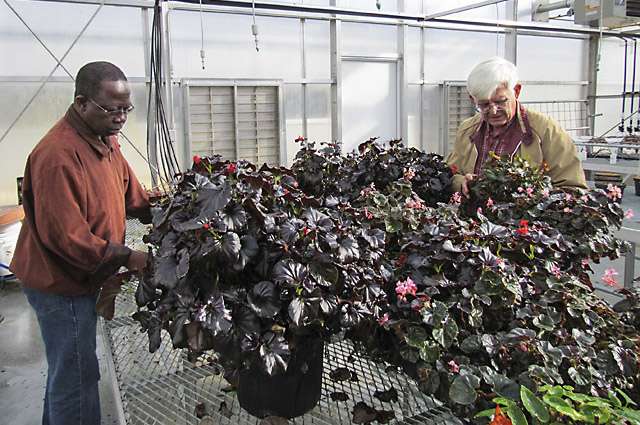New begonia germplasm lines both beautiful and sturdy

Two new begonia germplasm lines developed by Agricultural Research Service and collaborating scientists are now available for use in breeding elite varieties of the ornamental crop that can tolerate the heat and humidity of a Gulf Coast summer.
Begonia semperflorens is the most widely cultivated type of begonia and the fourth most popular bedding plant in the United States, generating $36 million in sales (2009). However, in Gulf Coast states like Mississippi, Georgia, Alabama, and Florida, the onset of summer can overwhelm these popular flowering perennials with intense heat and humidity, cutting short the plant's colorful presence in flowerbeds, hanging baskets, and containers.
Begonia lovers needn't despair much longer, though.
The two new germplasm lines, labeled FB08-59 and FB08-163, were officially released in September 2014 as a source of genetic material for plant breeders to use in transferring that heat tolerance to commercial varieties now grown.
"These begonia lines are already being used in the breeding programs of two major international ornamental seed companies," reports Cecil Pounders, a plant geneticist with the ARS Thad Cochran Southern Horticultural Research Laboratory in Poplarville, Mississippi. He collaborated on the begonia releases with fellow ARS plant geneticist Hamidou Sakhanokho and colleague Leopold Nyochembeng of Alabama A&M University.
The team used a conventional plant-breeding technique called "recurrent selection" to develop the two germplasm lines. FB08-59 is the top pick of several generations of offspring plants that were evaluated following crosses between the commercial begonia Kaylen and B. cucullata var. arenosicola, a herbaceous perennial species native to South America. FB08-163 is the top selection of a cross between Kaylen and another commercial begonia, Shanzi.
FB08-59 grows to a height of about 12 inches, and FB08-163 grows to about 20 inches. Both sport dark, waxy leaves that encircle purple-red flowers with specks of white in the petals and yellow stamens in their centers. But these begonias are more than just good looking; they are built to last, thanks to genes inherited from their South American parent that confer tolerance to heat, humidity, and other environmental stresses.
Indeed, in 5 years of trials, the two begonias thrived under a variety of stressful conditions—including exposure to overhead summer irrigation simulating rainfall conditions that promote disease development—that overwhelmed several commercial cultivars used as experimental controls.
In general, Vodka, Whisky, Gin, Senator, Inferno Red, Bada Bing Red, and Bada Boom Scarlet—varieties commonly planted in the South and grown under the same test conditions as FB08-59 and FB08-163—faired poorly, succumbing to a combination of heat stress and Pythium fungal infections, Cecil and his coauthors note in a paper published in the January 2015 issue of HortScience.
In addition to high stress tolerance, the new begonia lines also offer continuous (prolonged) bloom, compact growth, and excellent disease resistance—a winning combination of traits sure to please southern enthusiasts searching for additional summer colors to plant.
Journal information: HortScience
Provided by Agricultural Research Service



















